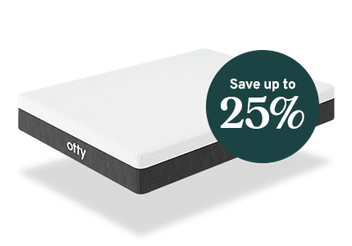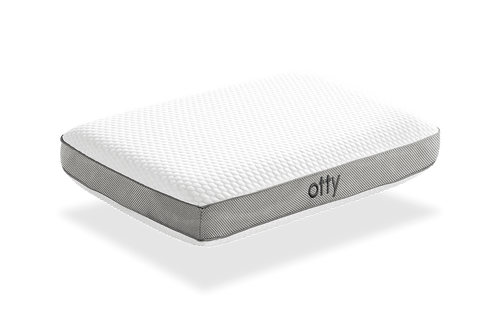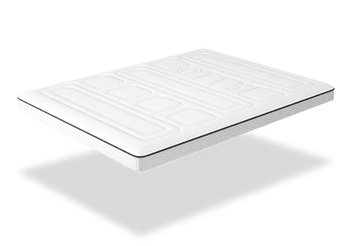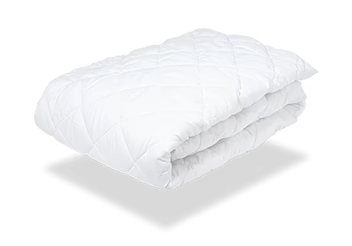Learn how to make a mattress softer with our easy-to-follow guide.
We'll explain about mattress firmness, exploring how it affects your sleep quality and, most importantly, how to soften your mattress if needed.
Table of contents
Why Is Mattress Firmness Important?
A mattress that is too soft may not provide the necessary support
A mattress that is too firm can cause back pain and disrupt your sleep.
How Does A Too-Firm Mattress Affect Sleep Quality?
A hard mattress might seem like a good idea initially, but it can lead to discomfort and restless nights. This is because a firm surface can disrupt your sleep by causing you to toss and turn throughout the night.
Over time, the effects of a hard mattress can become more severe. It can push your spine out of its natural alignment during sleep, which can cause back pain. This is not good for your back in the long run, and it's something you'll want to avoid.
The firmness level of your mattress can also affect how well you feel when you wake up. If you're waking up with new aches and pains, it's likely that your mattress is too firm. This is a clear sign that your mattress isn't providing the support and cushioning your body needs.
How to Make a Hard Mattress Softer
There are a number of ways to make a mattress softer, and not all of them come at a cost.
Remember, a comfortable bed is key to quality sleep. So, let's dive in and explore these methods to transform your hard bed into a soft and cosy haven.
Option 1 - Use a Mattress Topper
One of the most effective ways to make a hard mattress softer is by using a mattress topper.
This is a layer of cushioning that you place on top of your mattress to provide extra comfort and softness.
There are various types of mattress toppers available in the market, but memory foam toppers are particularly popular. They conform to your body shape, providing excellent support and comfort.
A mattress topper is not a permanent solution. If your mattress is old and uncomfortable, it might be time to consider investing in a new one. But in the meantime, a topper can certainly make your bed more comfortable and help you get a better night's sleep.
Our charcoal mattress topper offers all of the above for superb comfort and support.
A layer of cushioning that you place on top of your mattress to provide extra comfort and softness
One of the most effective ways to make a hard mattress softer
Not a permanent solution
Some cost associated
Adjust the Room Temperature
Adjusting the room temperature is a simple yet effective way to make your hard mattress softer.
Memory foam mattresses, in particular, are sensitive to temperature changes. They become softer in warmer environments and firmer in cooler ones.
If you find your bed too hard, try increasing the room temperature slightly. This will cause the memory foam to respond and soften, providing a more comfortable sleeping surface.
The key is to experiment with different temperatures until you find the perfect balance that suits your comfort needs. This is a cost-effective method to make your bed softer without investing in additional bedding accessories.
Memory foam mattresses, in particular, are sensitive to temperature changes
Cost-effective method
May not work with other mattress types
No guarantee it will work
Rotate and Flip Your Mattress
Rotating or flipping your mattress can be a simple yet effective way to make a hard mattress softer.
Over time, mattresses tend to wear more in the areas where we sleep the most. This can lead to uneven firmness and discomfort. By rotating your mattress 180 degrees, you're essentially giving the less worn areas a chance to serve you.
This can result in a softer feel, especially if the mattress has not been rotated for a while.
Flipping the mattress is another option, but it's important to note that not all mattresses are designed to be flipped. Some mattresses have a specific top and bottom side, and flipping them could potentially damage the mattress or negate its benefits.
Always check with your mattress manufacturer before deciding to flip your mattress.
Learn more with our guide to rotating your mattress.
Simple yet effective
No costs
Not all mattresses can be flipped
Will only work a few times before it stops being effective
Change Your Sleeping Position
If you're finding your mattress too hard, a simple change in your sleeping position could make a world of difference.
Certain positions are more compatible with firmer surfaces, such as sleeping on your back or stomach. These positions can help maintain spinal alignment, making a firm mattress feel more comfortable.
On the other hand, side sleepers might find a hard mattress less accommodating due to the lack of cushioning. Our pillow for side sleepers might also help,
So, before you rush to buy a new mattress or invest in a mattress topper, try changing your sleeping position. It's a cost-effective solution that might just make your bed feel a lot softer.
No costs
Easy to try and find what works for you
May not work if the mattress is old
May not work for your favoured sleeping position
Keeping Your Mattress Soft
Maintaining the softness of your mattress is not a one-time task, but a continuous process that requires regular attention. Just like any other household item, your mattress needs care and maintenance to keep it in optimal condition. This section will guide you on how to maintain your mattress for optimal softness, ensuring you get a comfortable sleep every night.
From rotating your mattress to proper cleaning, these simple yet effective steps can make a significant difference in the longevity and comfort of your mattress. So, let's delve into the details and make your bed the ultimate comfort zone.
Regular Rotation and Flipping
To maintain the softness of your mattress, regular rotation and flipping is crucial. This simple act can significantly extend the lifespan of your mattress and keep it feeling comfortable for longer.
Rotating your mattress involves turning it 180 degrees. This helps to distribute the wear and tear evenly across the surface, preventing any one area from becoming too worn out.
To make your mattress softer and prolong its life, regular rotation and flipping are key.
Proper Cleaning and Care
Proper cleaning and care are essential to maintain the softness of your mattress. It's not just about making your bed every day, but also about the deeper care that your mattress requires.
Firstly, it's crucial to keep your mattress clean. Regular vacuuming can help remove dust and allergens that may harden the surface. Use a soft brush attachment to avoid damaging the material.
Secondly, avoid eating or drinking on your mattress. Spills can seep into the mattress, causing it to harden over time. If a spill does occur, clean it immediately with a mild detergent and warm water.
Does a Hard Bed Cause Back Pain?
A hard bed can indeed cause discomfort, especially for side sleepers. This is because a firm mattress may not provide enough support to the body's pressure points, such as the shoulders and hips.
However, it's important to note that a bed that's too soft can also lead to back pain. This is because a soft bed may not provide the necessary support to maintain proper spinal alignment.
Summary and Key Takeaways
With the right tools and techniques you can transform a hard mattress into a soft bed that contours to your body
A mattress topper is probably the most effective method of making your mattress softer
Try rotating or flipping your mattress first before shelling out on a mattress topper
If nothing works to make your mattress softer, it's probably time to buy a new mattress









